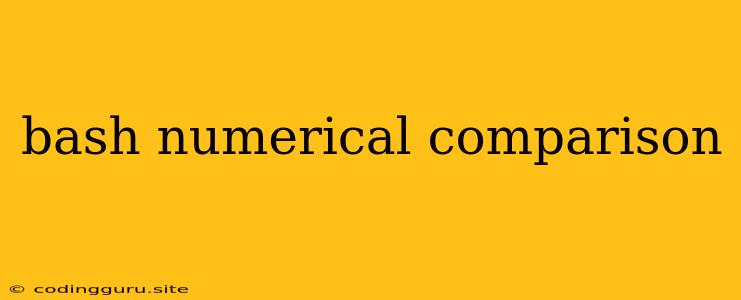Bash Numerical Comparison: A Guide to Comparing Numbers in Shell Scripts
Bash, the ubiquitous command-line interpreter for Linux and macOS, empowers users to perform a wide range of tasks. But what about comparing numbers? This is where bash numerical comparison comes into play. It's an essential skill for writing shell scripts that can make decisions based on numerical values.
The Basics of Bash Numerical Comparison
Bash uses operators to compare numerical values. These operators return a Boolean value, either "true" (represented as 0) or "false" (represented as 1). Let's explore the key operators:
- -eq (equal to): Checks if two numbers are equal.
if [ $num1 -eq $num2 ]; then echo "The numbers are equal" fi - -ne (not equal to): Checks if two numbers are not equal.
if [ $num1 -ne $num2 ]; then echo "The numbers are not equal" fi - -gt (greater than): Checks if the first number is greater than the second.
if [ $num1 -gt $num2 ]; then echo "$num1 is greater than $num2" fi - -ge (greater than or equal to): Checks if the first number is greater than or equal to the second.
if [ $num1 -ge $num2 ]; then echo "$num1 is greater than or equal to $num2" fi - -lt (less than): Checks if the first number is less than the second.
if [ $num1 -lt $num2 ]; then echo "$num1 is less than $num2" fi - -le (less than or equal to): Checks if the first number is less than or equal to the second.
if [ $num1 -le $num2 ]; then echo "$num1 is less than or equal to $num2" fi
Practical Examples of Bash Numerical Comparison
Example 1: Checking if a file size exceeds a limit
#!/bin/bash
file_size=$(du -b /path/to/file | awk '{print $1}')
max_size=1000000 # 1 MB limit
if [ $file_size -gt $max_size ]; then
echo "File size exceeds the limit!"
exit 1
fi
echo "File size is within the limit."
Example 2: Conditional Execution Based on Input
#!/bin/bash
read -p "Enter a number: " num
if [ $num -gt 10 ]; then
echo "You entered a number greater than 10!"
elif [ $num -lt 10 ]; then
echo "You entered a number less than 10!"
else
echo "You entered the number 10!"
fi
Beyond Simple Comparisons: Advanced Techniques
1. Arithmetic Expressions: Bash provides a powerful mechanism to perform arithmetic calculations using (( ... )). This can be combined with bash numerical comparison.
sum=$(( $num1 + $num2 ))
if [ $sum -gt 100 ]; then
echo "The sum is greater than 100."
fi
2. Floating-point Comparisons: Bash primarily works with integers. For floating-point comparisons, tools like bc (an arbitrary-precision calculator) are required.
if [ $(bc <<< "scale=2; $num1 > $num2") -eq 1 ]; then
echo "$num1 is greater than $num2"
fi
3. Error Handling: Always include error handling in your scripts. Use $? to check the exit status of commands. A non-zero exit status indicates an error.
if [ $? -ne 0 ]; then
echo "Error occurred!"
exit 1
fi
Conclusion
Bash numerical comparison is a fundamental aspect of writing effective and powerful shell scripts. Understanding the operators, combining them with arithmetic expressions, and incorporating error handling are key to taking your scripting abilities to the next level. Use this knowledge to automate tasks, analyze data, and streamline your work in the command line!
